Augmented Reality App Development: Features & Cost
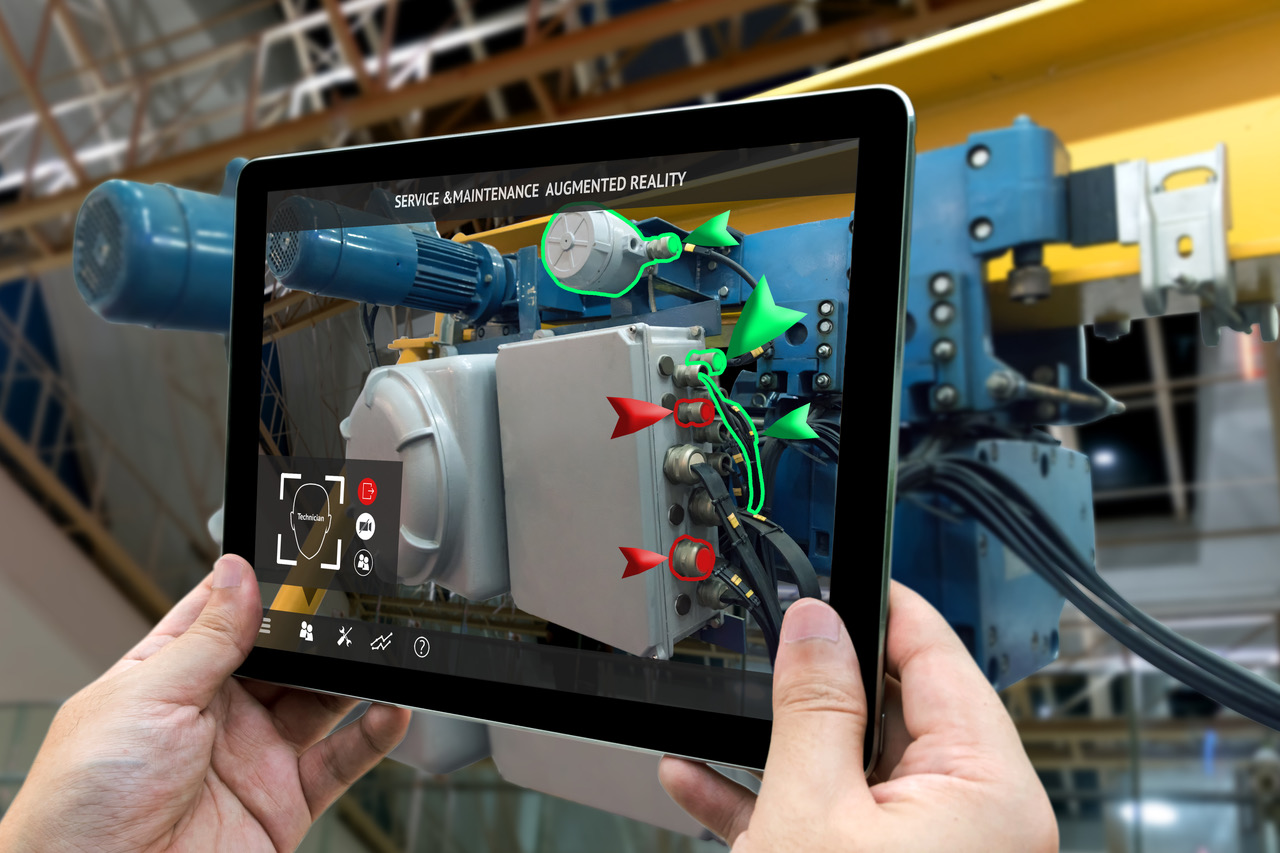
This article is intended for startups and businesses interested in augmented reality software development but not sure where to start, how to do it right, and whether they can afford it. Here you can learn how to build a mobile app and how much it may cost.
If you need advice, assistance, or experienced developers to create an augmented reality app for your organization, Alternative-spaces is here to help and share our vast experience!
Table of contents
- What types of augmented reality applications exist?
- Augmented reality app features to consider
- How to create an augmented reality app?
- How much does augmented reality app development cost?
- Alternative-spaces’s experience in augmented reality app development
- To recap
- FAQ
Augmented reality development is definitely a promising direction. According to Market Research Future’s research report of 2022, the augmented reality market should garner substantial traction and flourish in the coming years. Growing at a massive CAGR of 41.5% throughout the current decade, the global market should reach 461 billion USD by 2030.
The technology is being actively adopted primarily in medical training, education, retail, marketing, branding, design, modeling, construction, tourism, gaming, and entertainment, but it is worth exploring by virtually any industry or branch of business.
An augmented reality feature needn’t even be functional; it just makes any app more fun! For example, Tarot Tap, a social mobile app that Alternative-spaces helped create, includes an augmented reality mode. When a user turns on the rear or front camera, the virtual tarot cards’ vivid illustrations are projected either on their interior or landscape or positioned on their forehead, respectively.

This guide covers the entire augmented reality (AR) software development process, including the ideation, choice of technologies, development flow, and the factors determining the total cost. We’re focusing on mobile app-based AR as the more appealing format: smartphones are prevalent in the market and portable, making AR accessible to as many consumers as possible.
Let’s start with the basics.
What types of augmented reality applications exist?
An augmented reality application integrates visual and audio digital components into a mobile user’s field of view through the device’s camera. AR content typically consists of 3D models but can also include video and audio formats.
The simplest classification of AR apps is based on the trigger the mobile device uses:
Marker-based / image recognition AR applications
A QR code, icon, or another physical 2D or 3D object with an encoded ID, called a marker, acts as a trigger. The user scans it with their mobile device, and the app recognizes it and projects pre-programmed AR content, such as a piece of textual information, animation, or call-to-action, through the screen.
Markerless / location-based AR apps
In addition to a camera detecting environment patterns, this type of AR relies on mobile location awareness capabilities, such as:
- GPS
- digital compass
- accelerometer
- gyroscope
- magnetometer
- depth sensors
- BLE beacons
- VPS (Visual Positioning System)
- Low-range Wi-Fi Direct
- UWB (Ultra-WideBand)
The app relies on all these sensors and special algorithms to detect locations, recognize objects, and measure distances in the physical environment to accurately render 3D graphics on site. The appropriate location enables real-time interaction with AR objects.
Such AR apps are excellent for travelers, drivers, and open-world gamers. For example, an app can recommend places to visit on a street, provide real-time directions, guide a city tour, or supply trivia about a specific location.
AR apps can also scan physical objects, create 3D models, and then put these digital copies into cloud storage. 3D scanning technology is sensor-based too. Ikea Place is an example of this kind of AR mobile app. Interior designers, architects, engineers, and educators also appreciate such 3D simulations.

AR apps mixing virtual elements with physical objects and allowing real-life interactions are most in demand. However, every business and every situation is unique, and the pool of AR content variations, ways to apply it to reality, and users’ interactions with it are virtually endless.
Augmented reality app features to consider
Image revelations in augmented reality
The most basic AR experience consists of a QR or photo marker that reveals another image when scanned. This technology uses images in JPG or PNG formats, and it’s pretty easy to put easy-to-scan 2D tags on labels, business cards, marketing brochures, catalogs, textbooks, posters, artwork, etc.
For example, shoppers can scan QR codes and experience an extra dimension to a product, e.g., when AR highlights its unique features.

It’s not only QR codes and pictures that can trigger an application. For example, Optical Character Recognition can detect foreign words via the camera. The app then would find equivalents in a user’s preferred language to overlay the original text, facilitating the translation of signs or messages in real time.
AR image gallery
A scanned AR marker can also trigger a whole image gallery to open. For example, when a shopper scans a clothing item in a catalog, an AR gallery would show other color options or styles, overlay the scanned piece with matching clothes or accessories, and invite the viewer to proceed to the online store.
Augmented reality with a video
It’s possible to attach one or several video snippets to an AR marker, seemingly making images come to life or extending the story through full-screen videos, e.g., for marketing, entertainment, or instruction purposes.
In the case of multiple videos per marker, one piece will be retrieved randomly when a person scans the marker. If the same user rescans it, they will be able to watch a different video. You can upload the same video in multiple languages, but each user will view it in their preferred language (as per their app settings).
An AR video experience requires video in the formats of MP4, Full HD, or the longest side at 1920px.
Transparent video layer
If you need the AR content to interact with the physical environment, you may need to shoot the video content on a green background. For example, a clothing brand can present its fashion show in each consumer’s living room using this approach.
AR face masks
‘Face filters’ projected through a smartphone’s camera are not only for fun in social media apps. Users can also experiment with products like cosmetics, glasses, accessories, headwear, etc., using their mobile devices.
Similarly, an app can change the color of a real piece of furniture on a shopper’s mobile screen or show what a place looked like in the Middle Ages when a tourist scans a modern map. This technique is excellent for cause-and-effect demonstrations.
Static 3D models
The most basic option is to go for a static 3D model, adjusting its size and position towards the marker.
This application often complements printed materials but is also suitable for product demonstrations that don’t require much movement, such as furniture, electronics, and even real estate. For example, potential property buyers can see it come to life from a plain 2D blueprint. If users need to see how a potential purchase fits in the room, you may enable them to ‘walk around it’ and look at it from different angles in AR.
You can also let users ‘see through’ physical objects, e.g., during machinery and equipment presentations. You can enrich the 3D models with text or audio to deliver more valuable information on the revealed parts and processes.
Similarly, physicians and medical professors can use AR apps to superimpose views of bones, tissues, muscles, and organs on a patient’s body or images.
3D animations in AR
This content is basically 3D models, but they’re animated. This application will require creating an asset pack with animations.
360° tours in AR
Once a user scans a marker or otherwise triggers the experience, a virtual tour would open on their phone. Users would be able to explore the virtual environment by moving their mobile devices around in a manner similar to wearing a VR headset. The environment may present your office, store, event, or property you are trying to sell.
It’s possible to provide this experience using a panoramic JPG image or video. Such applications will likely require creating high-quality panoramic views and advanced help to shoot the necessary video.
NFTs in AR
Besides physical objects, users can also visualize their NFTs, interact with their 3D models, and share them with others through social media.
Augmented reality with calls-to-action
Any AR content can come with virtual buttons to enable consumers to take the desired action, e.g., to read more or make a purchase. Multiple AR buttons, preferably no more than five per screen, can lead to whatever digital destinations you want. You can also include Google Tracking links within the buttons to track conversions.
The user’s default language can determine the buttons’ language.
These are only a few examples. AR’s abilities in visualizing things and concepts for the benefit of a business are limited only by your imagination. AR paired with advanced artificial intelligence and machine learning algorithms can help provide more life-like experiences, improve app performance, and increase customer satisfaction.
How to create an augmented reality app?
For your convenience, we will divide the process of AR app development into six steps:
- Project discovery stage (research, requirements elicitation, and documentation)
- Choice of mobile developers for the project
- Technology stack decisions, including the choice of the optimal augmented reality platform
- Design stage (prototyping and the creation of 3D models)
- Development stage, including the back-end and mobile development, AR module development, and quality assurance (QA)
- The deployment and support phase
The following chapters will offer some practical advice for each stage.
1. Preparation for augmented reality application development
The development of any software product begins with the definition of business goals, i.e. what results you expect from implementing the mobile application or a particular AR feature.
If you are developing an app for your company’s employees, you need to thoroughly understand their needs and goals and design your AR app to solve critical issues for them.
If you develop a commercial product, you need to understand your target audience and competition. You can take the following steps:
- Analyze the local market state, find niches that still have space for new players, and list the leading applications.
- Explore the competitors’ offerings on Google Play Store and App Store, their business models, and ratings and reviews. Evaluate their features, design, AR content, and performance; list their strengths and weaknesses.
- Analyze your target audience’s demographics, interests, income, preferences, etc.
- Based on the collected data, create your ‘unique selling point,’ i.e. how your application can beat the competition.
We recommend preparing the following documents:
1. Product vision
Describe in detail how augmented reality in your app should work to complete tasks for the user and add value for a business and how the entire mobile app should grow your business.
2. Product requirements specification
If you don’t write a full-fledged product specification, at least prioritize the desired app features depending on your business goals and application type.
For example, the product developers may have to integrate:
- QR scanner
- Marker recognition
- GPS location tracking
- Maps
- Face and rear camera support
- A library of 2D and 3D elements
- Screen capturing for photos and video recording
- Built-in image editor
Besides the AR-related features and content, the app should have other essential components, such as:
- registration with a minimum of personal data and a convenient and safe login for subsequent entries;
- push notifications;
- social media integration that enables users to share their app content, attracting more potential customers to your business.
If you have a limited budget, are not sure of your app idea, or wish to test the water before investing in something big, building a BETA version or minimum viable product (MVP) first is a sensible solution.
3. Basic app design
A clickable prototype is preferable, but even pencil sketches of the main screen layouts will do at this stage.
If you don’t have the time or confidence for all this work, you can engage specialists right at your product’s discovery stage. This may also help you minimize development risks and avoid rework. For instance, Alternative-spaces’s experts can analyze your business idea and its viability, collect all requirements, suggest the best solutions and technologies, prepare the documentation and design, build a proof of concept, if needed, and estimate the budget.
2. Engagement of augmented reality app developers
You may need as many as eight people to develop an augmented reality app:
- UX/UI designer
- 2D/3D artist
- one or two AR developers
- one or two server developers
- QA engineer
- a project manager
The team lineup may vary depending on your needs. If your company has an internal augmented reality development team, they can proceed with all further steps. If not, the project can be challenging and quite risky without the help of experienced professionals.
Outsourcing the development rather than hiring an in-house team may be preferable for several reasons. Contracting an augmented reality app development company is the best way to enter the market and get a return on your investment faster.
A dedicated team of outsourcers brings to the table ample experience that can save you tons of time and money. The hourly rates of developers in developing countries can be several times lower than in the US, Western Europe, and other countries with a higher cost of living. Moreover, you save on software, human resources, and troubleshooting costs.
You may find augmented reality app development services on platforms like Clutch, IT Firms, GoodFirms, The Manifest, or TopDevelopers. You can view each IT vendor’s expertise, tech stack, location, rates, clients’ reviews, etc.
Read more: Best practices for outsourcing software development
However you look for AR app developers, experience and professionalism should come first, the price second.
External experts that have worked on dozens of projects using a plethora of AR development tools are likely to know all the best practices and pitfalls. Even if you don’t contract them to build your entire app, they will still share invaluable insights, identify risks early on, and help pick the right tech stack for your product.
3. Choice of tech stack to build an AR mobile application
Share all your product and business requirements with the software engineers so that they help you pick the best technologies and tools for building your custom AR software. The factors that may influence the development team’s decisions include:
- the app’s features and complexity
- budget
- deadlines
- the target operating platform
- support of the preferred programming language
- tech talent availability
- possibility and frequency of AR app updates
- monetization strategy and licenses
There are two approaches to mobile AR development:
- native app development
- cross-platform app development
Native AR app development lets developers take advantage of all the device’s capabilities. For a simpler application, cross-platform code may be enough. It may also be better if you aim for the fastest time-to-market.
If you opt for native mobile development, budget or time restrictions may force the team to choose between augmented reality platforms.
ARKit vs. ARCore
The AR development platforms, Apple ARKit for iOS devices and Google ARCore for Android devices, are nearly identical features-wise.
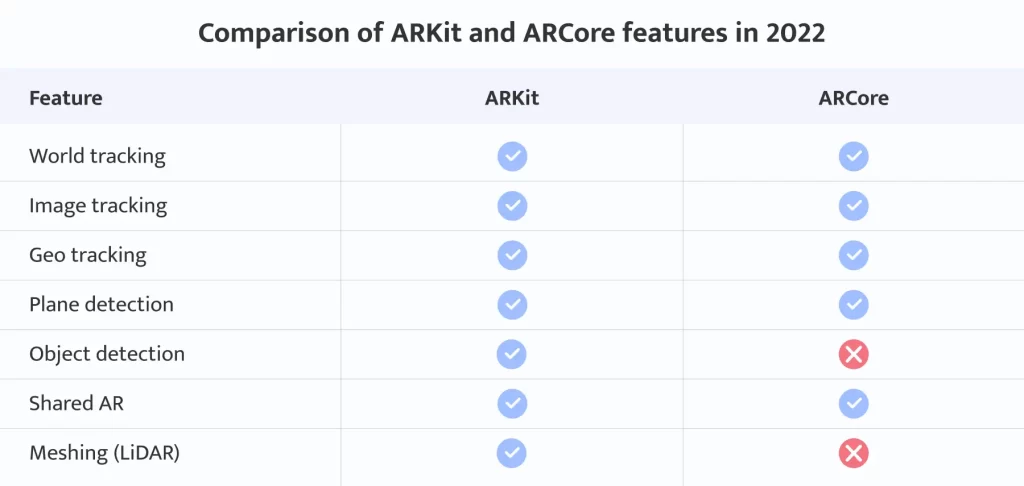
However, the iOS platform has the advantage of a consistent experience across all devices, whereas delivering a consistent AR experience across all Android devices from numerous manufacturers may be challenging.
Still, your choice will primarily depend on whether you target the owners of Apple or Android devices, depending on your business goals. For example, if you want to generate money through in-app purchases, go for ARKit. If you want to reach the maximum number of users, ARCore is your choice: Android dominates the global OS market.
Consider the devices that should support your AR application. Should it be the latest iPhone to showcase your top-notch high-performance AR features and content, or do you plan a simpler and less intensive experience that can run on virtually any device?
Aside from the SDKs for AR features, you will also need to use some standard technology for iOS or Android development:

Cross-platform AR app development options
This approach requires using third-party frameworks and software development kits (SDKs) to create AR experiences for both mobile OSs using one codebase.
An SDK is a pack of software tools and programs that facilitate adding special features to a product faster and without errors. It includes guides, processes, code samples, documentation, libraries, etc. Different SDKs are designed for different programming languages and platforms.
Ideally, the right SDK would support both iOS and Android. 3D object tracking and recognition are the most important features to look for. Cloud recognition will ensure that your mobile application recognizes markers without taking up much space on the device.
It must also support the Unity game engine. Unity AR Foundation is a robust solution for cross-platform AR app development. It supports plane detection, anchors, light estimation, 2D tracking, 3D tracking, body tracking, occlusion, and more. However, the framework still has limitations with some features for ARCore.
For example, ARToolKit supports both mobile platforms and is available as a plugin for Unity that supports Unity on Android and Unity on iOS.
Other popular options include, but are not limited to:
- Banuba
- DeepAR
- EasyAR
- Kudan
- Mapbox
- MaxST
- Visage SDK
- Vuforia
- Wikitude
- Xzimg

4. App design and AR content creation
AR app development involves experts in mobile user experience (UX) and user interface (UI) design and branding and 3D artists with image processing skills. Depending on the app type, they may have to create animated images or 3D models to project on real-world objects or environments.
The creation of 3D models includes the development of detailed 3D graphics, which should look as natural and realistic as possible.
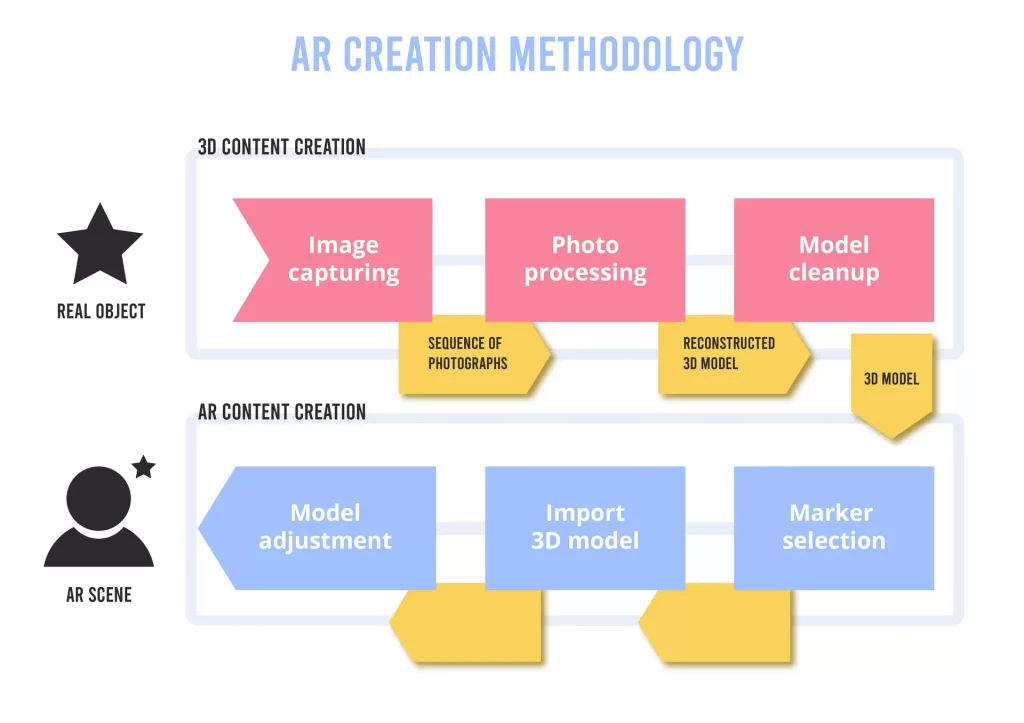
Alternatively, you can download a library of pre-built 2D/3D objects.
When designing an AR experience, bear in mind the following:
- Onboard your users who can be new to AR. Guide them with step-by-step tips to showcase the features.
- Avoid long session times since your users will be holding smartphones in their hands.
- Don’t overload your camera view with secondary components; the camera is your primary UI element, so keep it clear.
- Keep in mind your users’ safety, since people engrossed in your augmented reality app can expose themselves to real-life risks. Consider safe routes, send warning notifications, etc.
The designers must also work on your application’s logo, branding, visual style, screenshots for the app store pages, etc., aiming for a unique visual representation.
5. Front-end and back-end software development
Now it’s the software engineers’ turn to program the mobile app’s features, AR modules, and server side based on the produced specifications and design materials.
Before proper coding, the developers usually need to create the API contract, prioritize tech tasks, and choose optimal development tools and practices for the project.
The back-end development includes API and server implementation and sets up the connections between the mobile app, servers, databases, your website (if any), and third-party services.
The team must thoroughly test each implemented feature and technical solution to prevent problems with app performance, scalability, and reliability. Before release, make sure your mobile app is error-free and runs smoothly on different devices.
Simultaneously, prepare the technical documentation to facilitate the work of developers who will update, fix, or upgrade your AR application later.
6. Deployment and support
A commercial mobile AR application should be published on Google Play or AppStore, so anyone can install it. Again, the experience of a specialized development team will be advantageous when you submit it for review, especially if the product needs optimization according to Google Play’s and Apple App Store’s guidelines.
Upon the app’s approval and publication, you will have to monitor its status, number of downloads, and reviews.
Collect customer feedback to learn what they think about your app. Discuss complaints and feature requests with your development team, prioritize possible improvements, and make sure to fix any bugs and issues with future releases.
The app will also need periodic updates to meet SDKs’ and devices’ new requirements.
How much does augmented reality app development cost?
As with any other app, one may calculate the approximate budget by multiplying the involved specialists’ rate by the time required to complete the product. Let’s take a look at the main components of the AR app development cost.
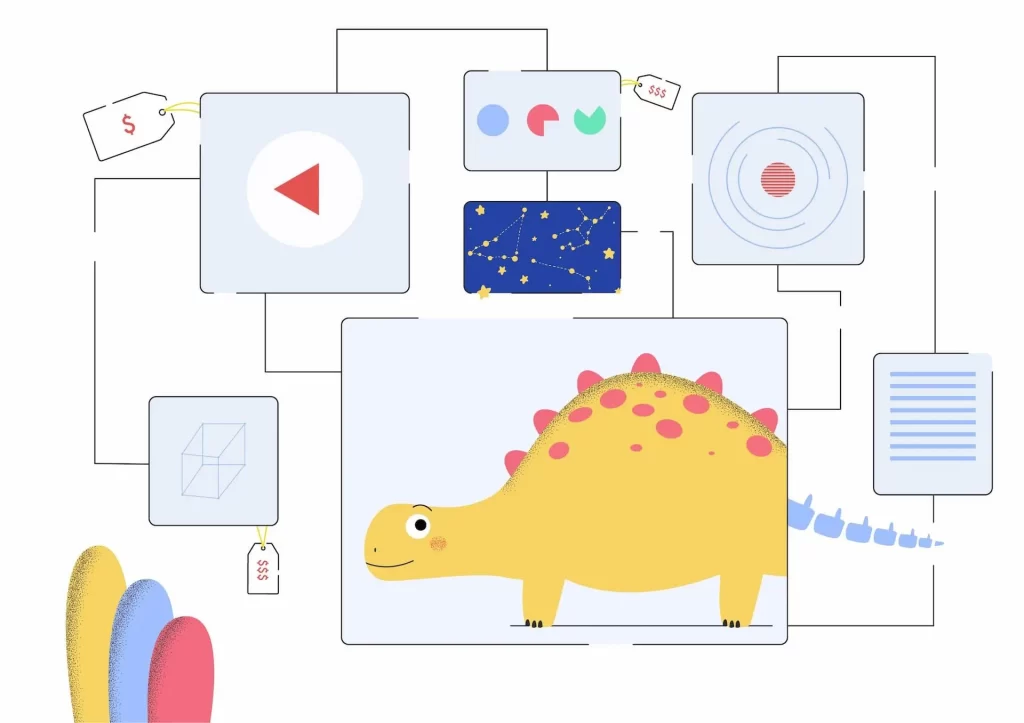
Type of AR
- Developers need about 40-160 hours to implement marker-based AR technology.
- Building a GPS-based solution leveraging cellular communication and a Wi-Fi connection takes 550-650 hours. The integration of sensors makes AR experiences costlier to develop.
- Since the ‘simultaneous localization and mapping’ technology (SLAM) uses complex algorithms and multiple sensors simultaneously, the development timeline may stretch to 1,000 hours.
AR content creation can also consume a significant part of your budget, especially if you want to create real-life environments.
AR functionalities and content
The time needed to make an augmented reality app correlates primarily with the number and complexity of the features to implement. The more complicated the coding, the more hours specialists spend on it, and the higher the app price.
Below is a list of possible essential features.
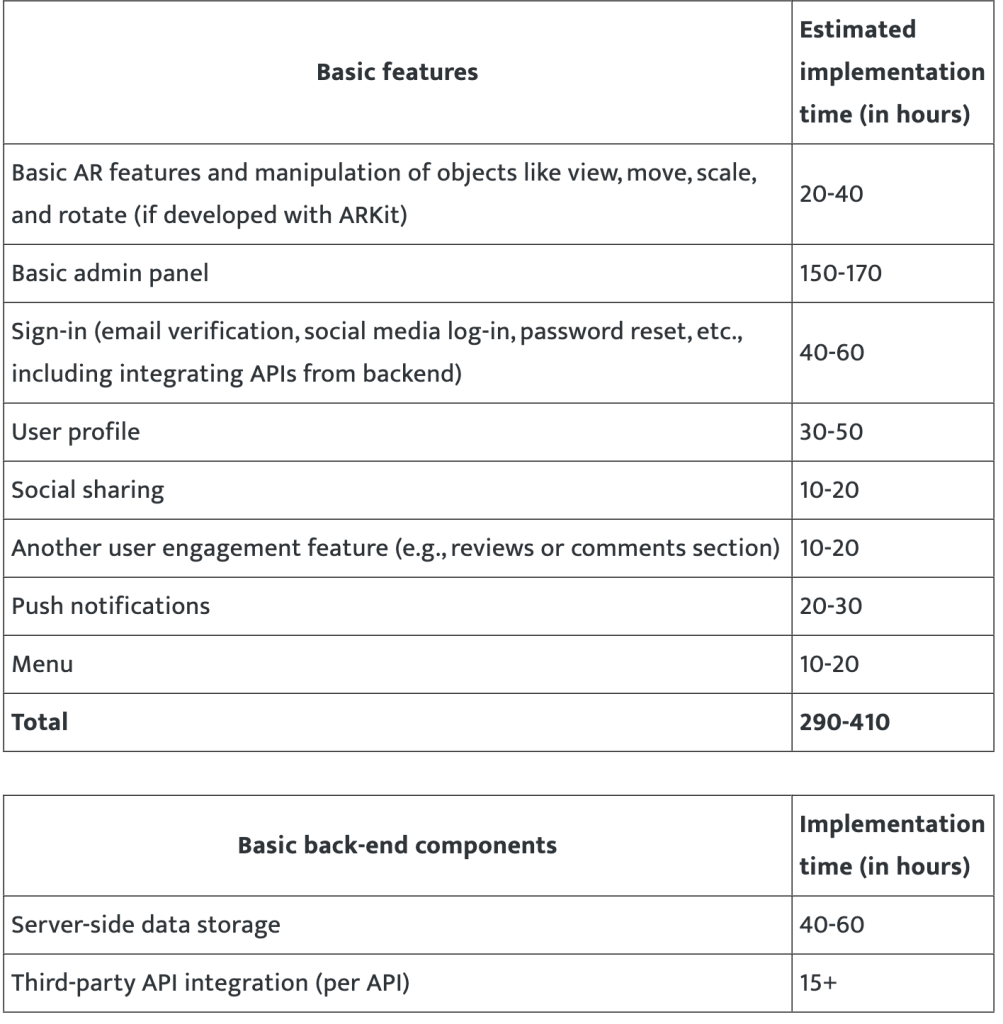
Usually, it takes a more sophisticated application to satisfy both the investor’s and users’ needs in the real world. Below, we have estimated the time needed to implement some extra features:
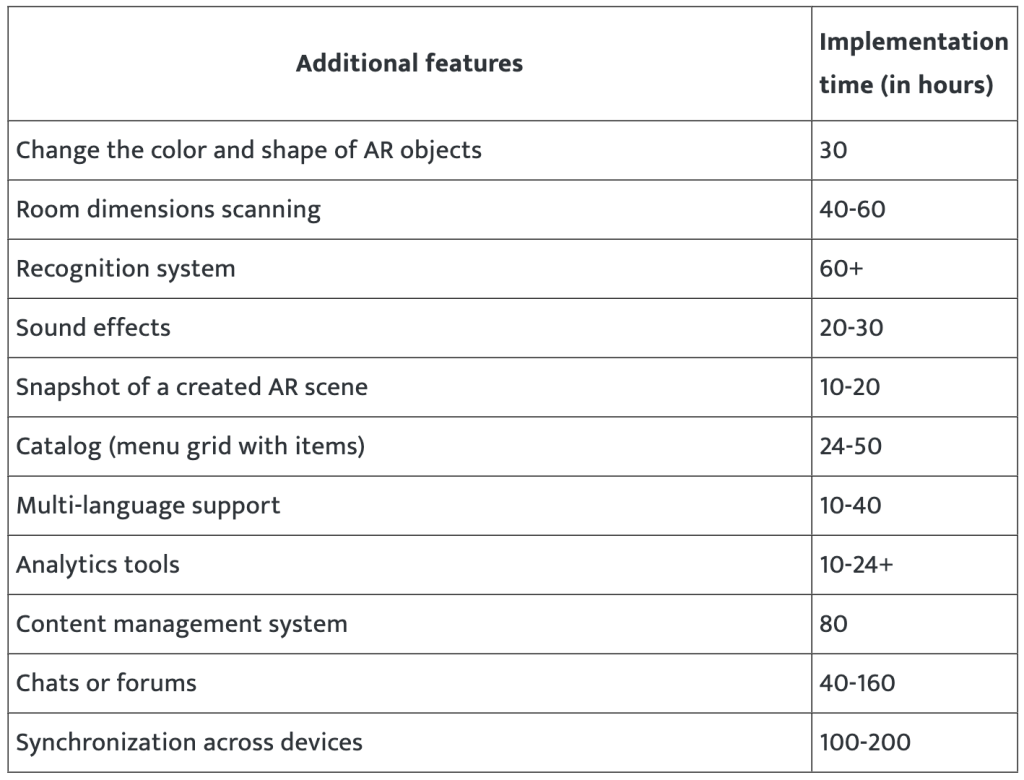
If you are developing a game, the additional features may include:

Tech stack choices
The choice of the OS to support and the SDK to use may impact your augmented reality app development cost in several ways. First, the creation of two native apps will take nearly twice as long as the development of one native app or cross-platform development.
While Apple’s and Google’s AR development platforms are free, others charge considerable fees. If you have to choose between the free and paid version of the product, we recommend choosing a paid, licensed version for adding better features. You can find some pricing details here:
Finally, the right set of tools simplifies and speeds up your app development process and helps adapt the product to various operating platforms, thus saving time/effort and reducing the cost of future fixes and product improvements.
AR app development rates
Your choice of the team impacts your augmented reality app development both in terms of skills and prices.
It takes experienced professionals to create augmented reality apps that will be successful. However, large renowned developer agencies may charge unreasonable fees ‘for the brand,’ and some won’t consider a budget of less than $100,000.
It’s wise to shop around but not necessarily search for the cheapest freelancers or agencies in the market. Professionals invest their time and money into mastering the necessary skills and constant improvement, so their rates are likely at least in the middle of the range.
The development team’s location often affects the final cost the most. Specialists across the globe have dramatically different hourly rates.

As a result, an app that requires 600 hours to build might cost around $80K in the US or $24K in Ukraine (if we calculate with Alternative-spaces’s average rate of $40/hour).
In the following section, we share some of our company’s experience in this field.
Alternative-spaces’s experience in augmented reality app development
Alternative-spaces has broad experience in designing and building virtual and augmented reality apps. Our experts know how to create top-notch AR mobile apps that fulfill each client’s needs, goals, and budget.
Wormhole Blue is another example of our AR game development. This application lets people interact with others and with AR objects – called points of interest (POIs) – connected with geodata. POIs are displayed on the globe view and on a map in augmented reality.
Quests are scattered around the world. When users find one, they can read the task and start the quest. Many are multi-step, each step with its own geoposition. The user must visit all locations and complete all tasks to finish the quest and receive a virtual or physical (as planned) reward at the end.
Users create their avatars and can see other players’ avatars in AR if they are within 100 meters of each other. Our team developed a custom geopositioning system for objects and avatars based on the ECEF coordinate system. It relies on a separate privacy layer, allowing for direct encrypted data exchange between users. Users can also use the app for video broadcasts. You can find more technical details in our case study.
We also built an AR mobile app that allows consumers to try on a watch on their wrist in augmented reality. The user places a printed marker at the wrist level, and the app overlays it with a wristwatch of the selected model.
The Alternative-spaces team also developed an AR service for web and offline systems that enables users to try on glasses and sunglasses virtually. The system uses realistic materials, reflections, a complex shader with refraction, and many other parameters for the lenses.
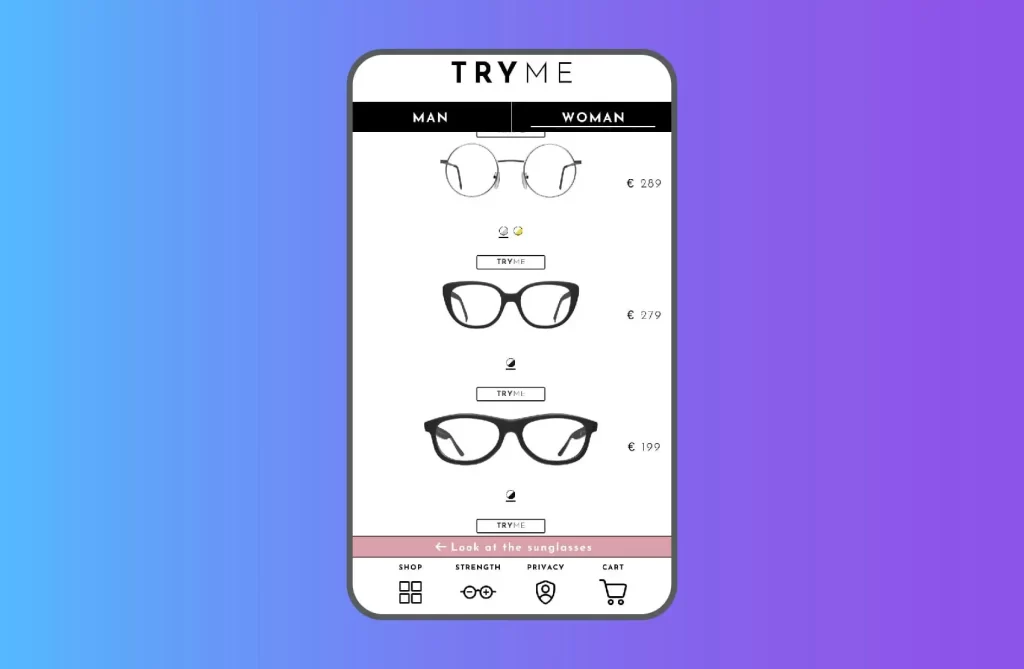
These experiences led to positive customer responses and increased sales. Such AR experiences are also excellent for many businesses because they don’t require special hardware. All a customer will need is their smartphone or a web browser.
To recap
Businesses in various fields have quickly realized the benefits augmented reality and its cousin, virtual reality, can offer.
In particular, AR technology can help companies of all sizes improve communication with customers and create an emotional connection with them, increase customer engagement, enrich the promotion of services and products, maximize conversions, increase the efficiency of employees, and improve product quality. Your AR-enriched product can become your competitive advantage.
Finding the right team is one of the secrets to successful augmented reality application development. With 350+ experts, 23 years of experience, and over 1,000 projects on its track record, Alternative-spaces is fully capable of helping you achieve your vision. Our augmented reality developers know how to innovate and create true-to-life experiences and effective solutions for various businesses.
So, whether you need assistance with your AR game development, want to enrich your existing mobile app with AR features, or have any other AR-related needs, please feel free to contact Alternative-spaces.
FAQ
What are the benefits of building an augmented reality application?
Some of the benefits resulting from AR software development include, but are not limited to, the following:
- Enhanced user experience increases engagement with a product or service;
- “Try before you buy” features that enable shoppers to visualize a piece of furniture in their room or virtually try on clothing, jewelry, makeup, glasses, etc., boost sales;
- AR technology facilitates comprehensive analytics for a better understanding of consumer behaviors.
- AR technology enables designing and visualizing projects, which significantly improves business efficiency and helps avoid rework and overpaying.
How to build an augmented reality app?
You may follow these steps to develop an augmented reality app:
- Research and business analysis, including market and target audience research, product requirements elicitation and writing, feature selection, and project planning.
- Selection of the AR app development approach, a suitable SDK, and other technologies.
- Design of the application and AR content.
- AR app front-end and back-end development and testing.
- Release and evaluation of the AR application.
What are the most popular AR development tools?
Besides the Google ARCore and Apple ARKit for native mobile AR app development, the top SDKs for the cross-platform approach are:
- ARToolKit
- DeepAR
- EasyAR
- Kudan
- MaxST
- Visage SDK
- Vuforia
- Wikitude
- Xzimg
How to choose the right AR app development company?
When choosing augmented reality app developers, consider factors such as portfolio, relevant expertise, experience, previous clients’ feedback, and even a convenient location and time zone. Arrange a video conference, listen to their ideas for developing your app, and otherwise evaluate their competence and eagerness to collaborate. The price tag should come second.
What augmented reality app development services do you provide?
Alternative-spaces’s services include the creation of:
- games
- virtual try-on apps
- promotional/marketing campaigns
- interactive environments in an educational format
- visualization tools for designers
- virtual interior design
- real estate business representation
- industrial visualization
- maps
- image recognition solutions, and more.
How much does it cost to develop an augmented reality app?
It is difficult to estimate an ‘average AR app development cost’ because it depends on multiple factors, such as:
- what functionality you will implement and how
- how many mobile platforms you target
- which SDKs you use
- to which country you outsource the app development
As a result, a simple demo application can cost about $10K, a more sophisticated app for iOS or Android can be estimated at around $60K, and for a feature- and graphic-rich AR app, the cost can jump up to $500K and beyond.
Content created by our partner, Onix-systems.
Source: https://onix-systems.com/blog/estimating-an-augmented-reality-app-development-cost Home
Home